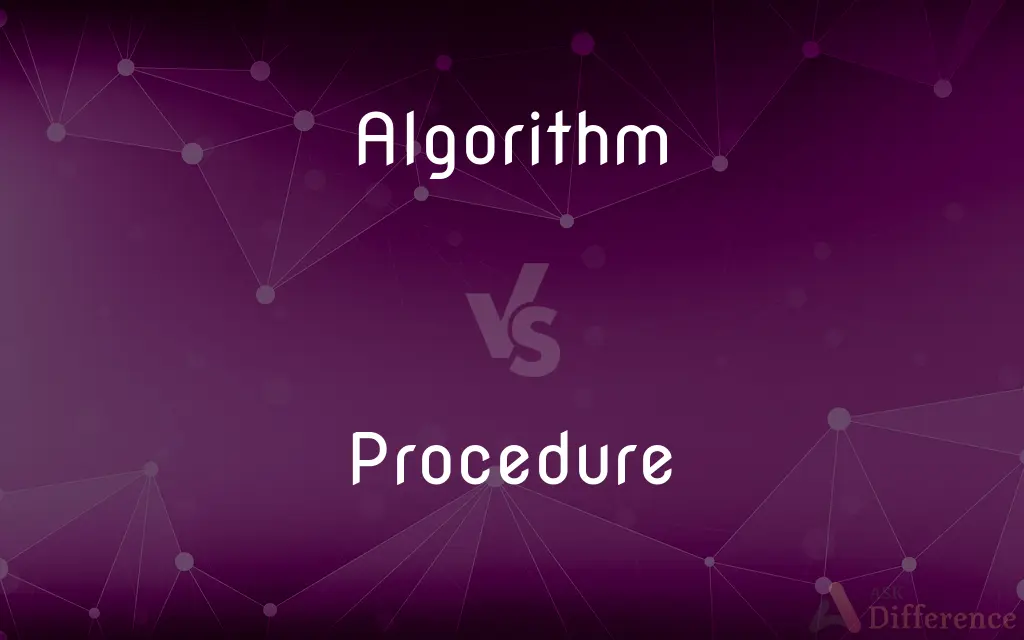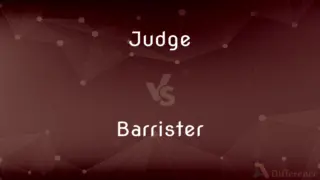Algorithm vs. Procedure — What's the Difference?
By Fiza Rafique & Urooj Arif — Updated on April 22, 2024
An algorithm is specific set of instructions for solving problems or performing tasks, designed to have clear steps and a predictable outcome. Procedure is broader series of actions for accomplishing certain task, often less rigid and more adaptable.

Difference Between Algorithm and Procedure
Table of Contents
ADVERTISEMENT
Key Differences
An algorithm is a detailed, step-by-step set of operations designed to perform a specific task or solve a problem, often used in mathematical and computer contexts. In contrast, a procedure is a series of actions conducted for a specific purpose, applicable in a wider range of fields including business, medicine, and everyday activities.
Algorithms are typically more structured and precise, with clear rules and sequences that must be followed to achieve a desired outcome. On the other hand, procedures may allow for more flexibility and personal judgment in their execution.
An algorithm must always produce the same output from the same input, ensuring predictability and repeatability. Whereas, procedures can vary based on the situation or the individual implementing them, potentially leading to different outcomes.
In computing, algorithms are fundamental for programming and creating software solutions, where precision and correctness are crucial. Meanwhile, procedures can be seen in organizational guidelines, where they serve as frameworks that guide but do not strictly dictate every step.
While algorithms are often validated through rigorous testing to ensure their correctness and efficiency, procedures are typically established through best practices and may evolve over time as they are adapted to new circumstances or knowledge.
ADVERTISEMENT
Comparison Chart
Definition
A set of mathematical instructions or rules arranged in a step-by-step process.
A series of actions conducted to achieve a certain task.
Flexibility
Fixed, with no deviation from the defined steps.
More flexible, can be adapted as needed.
Outcome Predictability
Predictable, produces the same result with the same input every time.
Can vary depending on different factors or implementations.
Field of Use
Primarily used in fields like computing and mathematics.
Used across various fields including business, science, and everyday life.
Structure
Highly structured and precise.
Structure can vary, generally less rigid than algorithms.
Compare with Definitions
Algorithm
A precise rule (or set of rules) specifying how to solve some problem.
Cryptographic algorithms secure data by encoding information.
Procedure
A technique or method of handling or managing something.
The laboratory procedure for chemical analysis must be strictly followed.
Algorithm
A step-by-step procedure for solving a problem or accomplishing some end.
The bakery algorithm ensures each batch of cookies bakes perfectly.
Procedure
A series of actions conducted in a certain order or manner.
The emergency procedure requires evacuating the building before checking for stragglers.
Algorithm
A formula or set of steps for solving a particular problem.
To find the greatest common divisor, the algorithm processes two numbers at a time.
Procedure
An established or official way of doing something.
The hiring procedure involves several interviews and a background check.
Algorithm
A process or set of rules to be followed in calculations or other problem-solving operations.
An algorithm in a computer program efficiently sorts names alphabetically.
Procedure
A set of instructions for performing a task.
The assembly procedure for the desk is included in the manual.
Algorithm
Any sequence of operations that can be precisely defined and mechanized.
The routing algorithm optimizes the path for data packets across the network.
Procedure
Steps taken in a legal action.
The procedure for filing a lawsuit begins with submitting a complaint to the court.
Algorithm
In mathematics and computer science, an algorithm ( (listen)) is a finite sequence of well-defined, computer-implementable instructions, typically to solve a class of specific problems or to perform a computation. Algorithms are always unambiguous and are used as specifications for performing calculations, data processing, automated reasoning, and other tasks.
Procedure
An established or official way of doing something
The police are now reviewing procedures
Parliamentary procedure
Algorithm
A finite set of unambiguous instructions that, given some set of initial conditions, can be performed in a prescribed sequence to achieve a certain goal and that has a recognizable set of end conditions.
Procedure
A manner of proceeding; a way of performing or effecting something
Standard procedure.
Algorithm
(countable) A collection of ordered steps that solve a mathematical problem. A precise step-by-step plan for a computational procedure that possibly begins with an input value and yields an output value in a finite number of steps.
Procedure
A series of steps taken to accomplish an end
A medical procedure.
Evacuation procedures.
Algorithm
Calculation with Arabic numerals; algorism.
Procedure
(Computers) A set of instructions that performs a specific task; a subroutine or function.
Algorithm
A precise rule (or set of rules) specifying how to solve some problem; a set of procedures guaranteed to find the solution to a problem.
Procedure
A set of established forms or methods for conducting the affairs of an organized body such as a business, club, or government.
Algorithm
A precise rule (or set of rules) specifying how to solve some problem
Procedure
(Law) The set of rules under which litigation is conducted, especially in contrast to the set of substantive legal principles that determine the merits of legal controversies and disputes.
Procedure
A particular method for performing a task.
Procedure
A series of small tasks or steps taken to accomplish an end.
Procedure
(uncountable) The set of established forms or methods of an organized body for accomplishing a certain task or tasks.
Ensure that you follow procedure when accessing customers' personal information.
Procedure
The steps taken in an action or other legal proceeding.
Procedure
(obsolete) That which results; issue; product.
Procedure
(computing) A subroutine or function coded to perform a specific task, but does not return a value.
Procedure
(medicine) A surgical operation.
Procedure
The act or manner of proceeding or moving forward; progress; process; operation; conduct.
Procedure
A step taken; an act performed; a proceeding; the steps taken in an action or other legal proceeding.
Procedure
That which results; issue; product.
Procedure
A particular course of action intended to achieve a result;
The procedure of obtaining a driver's license
It was a process of trial and error
Procedure
A process or series of acts especially of a practical or mechanical nature involved in a particular form of work;
The operations in building a house
Certain machine tool operations
Procedure
A set sequence of steps, part of larger computer program
Procedure
A mode of conducting legal and parliamentary proceedings
Common Curiosities
Can a procedure include multiple algorithms?
Yes, a procedure can encompass multiple algorithms, especially in complex tasks where different computational steps are required.
How are algorithms tested for effectiveness?
Algorithms are typically tested through simulations, real-world applications, and benchmarking against established standards to ensure they perform as expected.
How does the rigidity of an algorithm affect its application?
The rigidity ensures that an algorithm reliably produces the same results under the same conditions, which is critical for applications requiring high accuracy and consistency.
What is an example of a procedure that is not an algorithm?
An employee onboarding procedure, which may adapt based on the role or the new hire's previous experience, is a good example.
What is the role of algorithms in artificial intelligence?
Algorithms are foundational to artificial intelligence, enabling machines to learn from data, make decisions, and improve over time through machine learning techniques.
What are typical examples of algorithms in daily life?
Algorithms are used in GPS for finding the best route, in search engines to retrieve information, and in online shopping recommendations.
What roles do procedures play in organizational settings?
In organizations, procedures standardize operations, ensuring consistency and efficiency across various functions and departments.
What is the importance of flexibility in procedures?
Flexibility in procedures allows them to be adapted to changing conditions and individual cases, enhancing their applicability in dynamic environments.
How do cultural differences impact the implementation of procedures?
Cultural differences can significantly impact how procedures are interpreted and executed, requiring adaptations to fit local norms and practices.
Do procedures always require manual execution?
No, some procedures can be automated, especially routine or repetitive tasks, but others may still require human judgment and intervention.
How are procedures documented and communicated?
Procedures are often documented in manuals, guidelines, or digital formats and communicated through training sessions, workshops, or digital platforms.
Are there ethical considerations in using algorithms?
Yes, ethical considerations include bias in algorithmic decisions, transparency of algorithmic processes, and the impact of automation on employment.
Can algorithms be created without computer programming?
Yes, algorithms can be conceptualized on paper and used in non-computer tasks, like cooking recipes or instructions for manual calculations.
What are some challenges in designing effective algorithms?
Challenges include ensuring complexity is manageable, the algorithm is efficient in terms of time and resources, and it can handle exceptions or unexpected inputs.
How do updates to procedures differ from updates to algorithms?
Procedures are often updated to improve effectiveness or adapt to new laws and technologies, whereas algorithm updates typically focus on increasing accuracy, efficiency, or handling new types of data.
Share Your Discovery

Previous Comparison
Text vs. Chat
Next Comparison
Judge vs. BarristerAuthor Spotlight
Written by
Fiza RafiqueFiza Rafique is a skilled content writer at AskDifference.com, where she meticulously refines and enhances written pieces. Drawing from her vast editorial expertise, Fiza ensures clarity, accuracy, and precision in every article. Passionate about language, she continually seeks to elevate the quality of content for readers worldwide.
Co-written by
Urooj ArifUrooj is a skilled content writer at Ask Difference, known for her exceptional ability to simplify complex topics into engaging and informative content. With a passion for research and a flair for clear, concise writing, she consistently delivers articles that resonate with our diverse audience.
















































